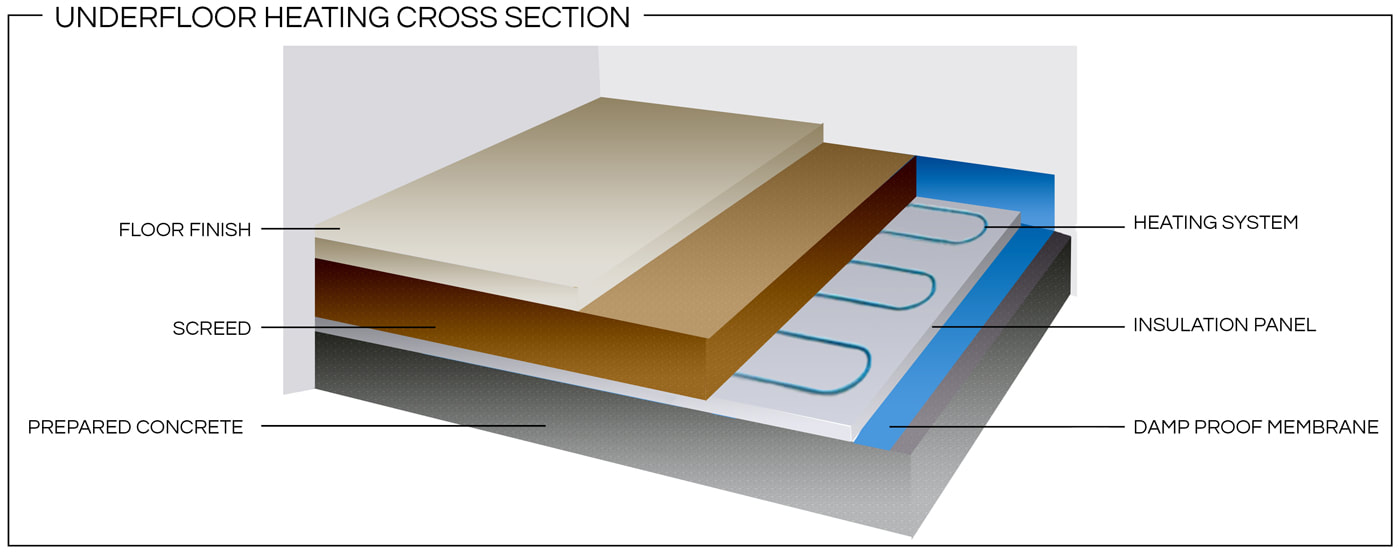Even though cement has great insulation properties, which means it is not as cold as many would believe, some clients still prefer to have their home warm and snug in the cold winter months. The question “Can I use underfloor heating with my Cemcrete floors?” is a frequent enquiry. Below we have put together all the information you will need to achieve a successful underfloor heating system in conjunction with a Cemcrete floor finish.
|
How does it work?
New build floors: For a new build, you would either have a “block and beam” or concrete slab substrate. It is then advisable to have at least 50mm of polyurethane insulation above your slab, unless you are using polystyrene as your insulation, then a minimum of 80mm polystyrene is required. This will minimize heat loss during the winter, as well as condensation of humid air during the summer. The underfloor heating will be laid down (electrical or water pipes) and fixed as per the manufacturer’s specifications. A standard sand / cement topping mix of about 70mm will then be applied over your underfloor heating pipes, preferably a wetter mix so that the screed can self-compact without stamping which could risk damaging the heating system. Cemcrete’s Colour Hardener can then be floated into this newly laid screed (while it is still wet) to colour the surface and give your floor a unique decorative cement-based finish. Existing floors: When looking at an existing floor where a standard tile has been removed, one is left with about 6-10mm of space to apply a new coating onto, ideal for our renovation products like CreteCote and RenoCrete. However, when one wants to incorporate underfloor heating into this scenario things become a little more complicated. As mentioned above a build-up of at least 70mm floating topping is necessary above the underfloor heating. Taking existing doors etc into consideration, this might be tricky (unless you are willing to saw down the bottom of your door). One can also opt to chop out a piece of the existing screed to provide the needed space for the 120mm combined topping and insulation. Even though there are many options out there with thin, self-levelling screeds and underfloor heating – these are not viable in conjunction with Cemcrete products as the decorative coating could crack due to the direct heat. Thus, a sand/cement topping is needed to limit the chance of cracking. Another great option for existing floors is to make use of an electric carpet - warming cold spots in any room of the home. Simply place the heating mat under your area rug and plug it in. This can also be moved around the house where needed. |
|
Will it cause cracking?
An underfloor heating system in concrete relies on the thermal conductivity of the screed to transfer heat into the room. It is for this reason that it is crucial to gradually introduce heating to avoid thermally shocking the surface due to rapid changes in temperature. It is advisable to leave your screed for 3 months, post installation, before turning the heat on to allow for the proper curing time without thermally shocking the concrete. After the recommended 3 months it is important to gradually introduce heat to the screeded surface a few degrees at a time. These are the steps to be taken to minimize the risk of cracking; if these steps are not properly followed then the risk of excessive cracking can be increased. Can I apply Cemcrete floor finishing over existing underfloor heating?
Yes, you can. However first check the existing floor for any cracking. This can be done by mist spraying water onto the surface which will show up any cracks. Visible cracking would indicate that the floor has been thermally shocked by the underfloor heating, and these cracks may migrate through to the new decorative coating or may require further preparation and precautions before the application thereof. If no thermal shock has taken place, a Cemcrete floor overlay can be applied directly. It is still important to follow the steps of gradual heating as a precautionary step to avoid cracking of the decorative overlay. |
Following these guidelines will let you enjoy a lovely heated Cemcrete floor during those rather chilly months.
To ensure your project runs smoothly when using a Cemcrete finish in conjunction with underfloor heating, please contact one of our branches for further technical assistance.
To ensure your project runs smoothly when using a Cemcrete finish in conjunction with underfloor heating, please contact one of our branches for further technical assistance.



